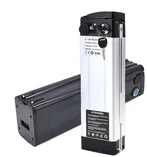
It is difficult to deduce the range of electric bicycle batteries in practical applications only by looking at the voltage of the battery. If the assumption is under optimal conditions, that is moderate speed, moderate temperature, flat terrain and no overload, for a 48V 10Ah battery with a capacity of 480Wh, the average power consumption is assumed to be 30W/ mi: range = 480Wh / 30W/ mi = 16 miles. That's a 48-volt electric bike with a range of 16 miles on a single charge. In the actual application, it will change according to the situation of use. Please continue reading below for details on how to calculate it.

1. Understanding the Basics of a 48V Electric Bike Battery
A 48V ebike battery is widely regarded as a standard in the industry, balancing power and efficiency for most riders. The voltage (V) represents the force pushing the current through the system, and higher voltage typically means better performance, especially on hills or when accelerating. But the battery's longevity-or how far it can take you on a single charge-depends on more than just voltage.

2. Key Factors That Affect Battery Life
Several factors influence how long a 48V battery can last on a single charge:
a. Battery Capacity (Wh)
Battery capacity is measured in watt-hours (Wh), which is the product of voltage (V) and amp-hours (Ah). For example, a 48V 10Ah battery has a capacity of 480Wh. The higher the capacity, the longer the range and better battery performance.
b. Rider's Weight and Load
Heavier riders or additional cargo, such as on a fat tire electric bike, can significantly reduce the range. Extra weight requires more energy to propel the bike, leading to faster battery drain.
c. Terrain and Riding Conditions
Flat, smooth roads allow for maximum range, while hilly, rough, or off-road conditions increase power consumption. Urban environments with frequent stops and starts also impact battery efficiency.
d. Riding Speed and Pedal Assist Level
Higher speeds and using high levels of pedal assist demand more power, reducing battery range. Eco modes or lower assist levels can extend your ride by conserving battery energy.
e. Wind and Weather Conditions
Riding against strong headwinds or in extreme temperatures can affect battery performance. Cold weather, in particular, can reduce the battery's effective capacity, while hot conditions may shorten its overall lifespan.
f. Tire Pressure and Bike Maintenance
Proper tire inflation reduces rolling resistance, improving efficiency. Well-maintained chains, brakes, and gears also ensure smoother riding and less energy waste, making regular maintenance crucial.
3. Estimating Range: The Ideal Formula
To give a more scientific approach to estimating battery life, we can use a simplified formula that takes into account the battery capacity and average power consumption:
Range (miles) = Battery Capacity (Wh) / Average Power Consumption (W/mile)
Breaking Down the Formula:
Battery Capacity (Wh): Calculated by multiplying the battery's voltage by its amp-hour rating. For example, a 48V 10Ah battery equates to 480Wh.
Average Power Consumption (W/mile): The amount of energy the bike uses per mile, which can vary based on the factors above. For typical riding conditions, a general estimate is 25-35 W/mile.
Example Calculation:
For a 48V 10Ah battery with a capacity of 480Wh, assuming an average consumption of 30 W/mile:
Range = 480Wh / 30W/mile = 16 miles
This idealized range assumes optimal conditions with moderate speed, flat terrain, and no excessive load.

4. Real-World Applications and Adjustments
While the formula gives a good baseline, real-world conditions often deviate. For example, if riding uphill or in windy conditions, the average power consumption might rise to 40-50 W/mile, reducing your range accordingly. Conversely, leisurely rides on flat roads with light pedal assist could improve efficiency, pushing your range higher than the estimated value.
5. Tips to Extend Your Battery's Range and Lifespan
Maximizing your electric bike battery's lifespan and range involves a combination of smart riding habits and diligent maintenance. Here are some expert tips:
a. Optimal Charging Practices
To extend its life, avoid overcharging your battery and never fully discharge it, as these practices can degrade lithium ion batteries over time. Charge the battery before it drops below 20%, and try to unplug it once it's fully charged.
b. Regular Maintenance
Keep your bike in top condition with regular maintenance checks. Lubricate the chain, keep tires properly inflated, and ensure that the brakes and gears are adjusted correctly.
c. Storing the Battery in a Cool, Dry Place
When storing the battery, always keep it in a cool dry environment, avoiding extreme temperatures which can negatively impact performance. Heat accelerates battery degradation, while cold conditions reduce capacity temporarily.
d. Reduce Power Consumption
Use lower pedal assist modes when possible, especially on flat terrain or when not in a hurry. Smooth and steady acceleration also helps conserve energy.
e. Monitor Charging Cycles
Each battery has a limited number of charging cycles before its performance begins to degrade. To get the most out of your high-quality battery, charge it correctly and avoid letting it sit unused for long periods at full charge.

6. Frequently Asked Questions (FAQ)
Q: How often should I replace my e-bike battery?
A: Typically, an e-bike battery lasts 500-1000 charge cycles, which translates to 3-5 years for average riders. Performance will degrade over time, and you'll notice reduced range as the battery ages.
Q: Can I use a different voltage battery on my e-bike?
A: Always stick to the manufacturer's recommendations. Using a different voltage can damage the motor or controller and void your warranty.
Q: How do I know when it's time to replace my battery?
A: If your range drops significantly and charging times increase, it may be time to replace your battery. Professional testing can provide a definitive answer.








